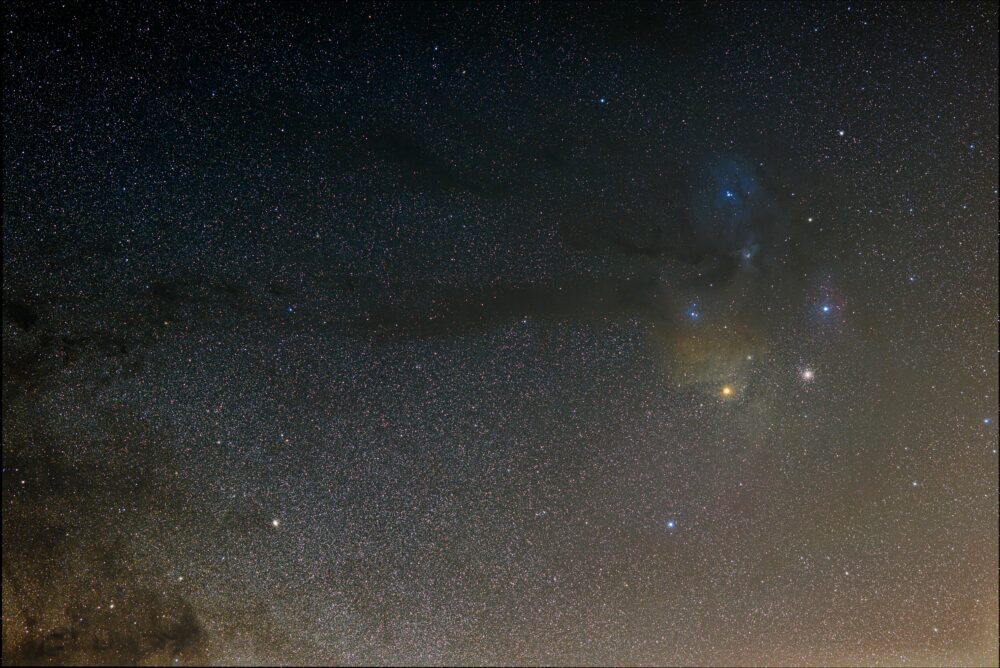By Galen Gisler, PEEC Planetarium Volunteer & Board Member
Some things in life are eminently predictable. It will be hot in New Mexico in the summer, and we will likely have thunderstorms. The moon will go through all its phases ever month—new, first quarter, full, last quarter, then new again. And when there’s no moon in the evening sky (two weeks out of every lunar month), summer brings us the glorious Milky Way, stretching from Scorpius in the South all the way to Cassiopeia in the North, passing the Summer Triangle (Altair in Aquila, Vega in Lyra, and Deneb in Cygnus) along the way. Go to a nice spot far from lights to appreciate the view. Overlook Park in White Rock is a good choice, so is the Kwage Mesa trailhead area on North Mesa. Better yet, get out of town into the Jemez Mountains or north towards Abiquiu. If you have binoculars, aim them at the Milky Way starting at Scorpius and follow it, seeing how many more stars you can see than with your naked eyes. With even a small telescope you can also see the faint wispy nebulae (clouds of glowing gas) that adorn the plane of our galaxy. You might even see Rho Ophiuchi.
Also predictable, this summer we will see only two planets in the evening sky: Mars and (just barely) Mercury. Early risers may see Saturn and Venus in the morning sky, but Jupiter will be invisible, too close to the Sun. Venus has already passed its greatest morning brilliancy, but is still very bright. If you are intrepid enough to go after Saturn with a telescope in the early morning, know that its rings will be nearly edge on to us, and almost invisible. However, because of that alignment, we are now in the season of Titan shadow transits, which occur only every 15 years. There will be one every 16 days or so, from late May through September.
There will also be some meteor showers worth watching for: the Southern delta Aquarids and the alpha Capricornids, both peaking July 29-30 when the Moon is a waxing crescent, 26% full and setting before midnight. Neither of these is as strong as the Perseid shower, which peaks August 12-13. On that night, the Moon will be a waning gibbous, 89% full and up all night, so the Perseids may disappoint. We don’t expect any bright comets this summer, but we could be surprised. Comet 24P/Schaumasse, an 8-year periodic comet, will make its closest approach in January 2026, and may be visible to binocular observers in the early morning sky this summer, setting before Venus in the West, in the constellation Taurus. Much more spectacular, if it happens at all this summer, is the expected recurrent nova outburst of the star T Coronae Borealis (T CrB). This star is normally too faint (10th magnitude) to see without strong binoculars, but has been observed to flare up several thousand-fold on two previous occasions, in 1866 and 1946, suggesting an 80-year flare-up periodicity. Accordingly, astronomers have been watching it carefully for the last couple years, expecting it to flare again. Corona Borealis (the northern crown) is an inconspicuous constellation in the form of a rough semicircle between the more prominent constellations of Bootes and Hercules. If T CrB flares this summer, it will be easily visible to the naked eye and worth watching for on our starry summer evenings.
The County-sponsored Dark Nights, hosted by the Pajarito Astronomers, will be held at Overlook Park in White Rock on July 26th, August 23rd, September 20th, October 11th, and November 15th, weather permitting. These are usually held on the Saturday evenings closest to the new moon. There will be telescopes available for public viewing. And if you bring your own telescope, and need help with it, you’ll meet some friendly experts!
Photo: Rho Ophiuchi by Ryan Rudoplh
This article was featured in the Summer 2025 Edition of Nature Notes, PEEC’s quarterly newsletter mailed to members. PEEC activities and events are open to everyone; however, members receive exclusive benefits such as discounts on programs and gift shop merchandise. Annual memberships start at $35. To learn more, visit peecnature.org/support/membership/.

